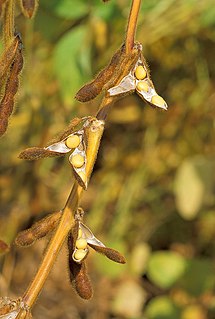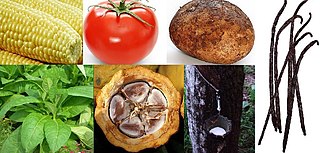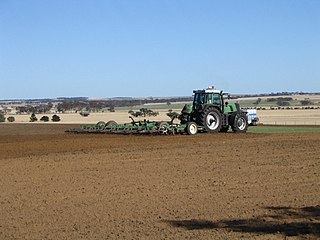
Sowing is the process of planting. An area or object that has had seeds planted in it will be described as being sowed.

Crop rotation is the practice of growing a series of dissimilar or different types of crops in the same area in sequenced seasons. It is done so that the soil of farms is not used for only one set of nutrients. It helps in reducing soil erosion and increases soil fertility and crop yield.
Conservation agriculture (CA) can be defined by a statement given by the Food and Agriculture Organization of the United Nations as “a concept for resource-saving agricultural crop production that strives to achieve acceptable profits together with high and sustained production levels while concurrently conserving the environment”.

Agroecology is the study of ecological processes applied to agricultural production systems. Bringing ecological principles to bear in agroecosystems can suggest novel management approaches that would not otherwise be considered. The term is often used imprecisely and may refer to "a science, a movement, [or] a practice". Agroecologists study a variety of agroecosystems. The field of agroecology is not associated with any one particular method of farming, whether it be organic, integrated, or conventional, intensive or extensive. However, it has much more in common with organic and integrated farming.

A seedbed or seedling bed is the local soil environment in which seeds are planted. Often it comprises not only the soil but also a specially prepared cold frame, hotbed or raised bed used to grow the seedlings in a controlled environment into larger young plants before transplanting them into a garden or field. A seedling bed is used to increase the number of seeds that germinate.
A false or stale seed bed is a seedbed created some weeks before seed is due to be sown. The early seedbed is used a weed control technique. It is designed to germinate weed seeds that have been disturbed and brought to the soil surface during cultivation, so that the young weeds can then be eliminated. The tilled soil increases the chance of weed seed germination as the fine soil allows seed to grow rapidly than in compacted soil and dormant seeds are brought to the surface. The weeds must then be destroyed before they can create new seeds. By destroying them early, the farmer eliminates most of that season's annual weeds, and nominally increases soil nutrient content.

Dryland farming and dry farming encompass specific agricultural techniques for the non-irrigated cultivation of crops. Dryland farming is associated with drylands, areas characterized by a cool wet season that is followed by a warm dry season. They are also associated with arid conditions or areas prone to drought or having scarce water resources. Additionally, arid-zone agriculture is being developed for this purpose.

No-till farming is a way of growing crops or pasture from year to year without disturbing the soil through tillage. No-till is an agricultural technique which increases the amount of water that infiltrates into the soil, the soil's retention of organic matter and its cycling of nutrients. In many agricultural regions, it can reduce or eliminate soil erosion. It increases the amount and variety of life in and on the soil, including disease-causing organisms and disease organisms. The most powerful benefit of no-tillage is improvement in soil biological fertility, making soils more resilient. Farm operations are made much more efficient, particularly improved time of sowing and better trafficability of farm operations.
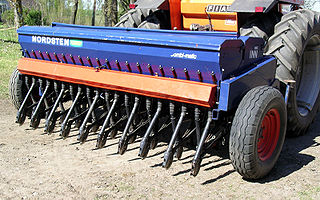
A seed drill is a device that sows the seeds for crops by metering out the individual seeds, positioning them in the soil, and covering them to a certain average depth. This makes sure the seed will be placed evenly.

In agriculture, gardening, and forestry, broadcast seeding is a method of seeding that involves scattering seed, by hand or mechanically, over a relatively large area. This is in contrast to:
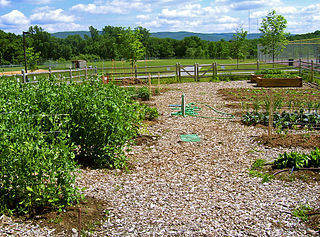
Organic horticulture is the science and art of growing fruits, vegetables, flowers, or ornamental plants by following the essential principles of organic agriculture in soil building and conservation, pest management, and heirloom variety preservation.

Soil conservation is the preventing of soil loss from erosion or reduced fertility caused by over usage, acidification, salinization or other chemical soil contamination.

Intensive crop farming is a modern form of intensive farming that refers to the industrialized production of crops. Intensive crop farming's methods include innovation in agricultural machinery, farming methods, genetic engineering technology, techniques for achieving economies of scale in production, the creation of new markets for consumption, patent protection of genetic information, and global trade. These methods are widespread in developed nations.
Phialophora gregata is a Deuteromycete fungus that is a plant pathogen which causes the disease commonly known as "brown stem rot of soybean. P. gregata does not produce survival structures, but has the ability to overwinter as mycelium in decaying soybean residue.
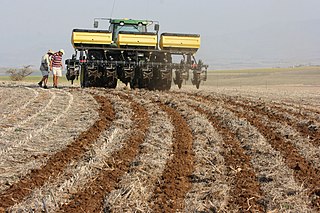
Strip-till is a conservation system that uses a minimum tillage. It combines the soil drying and warming benefits of conventional tillage with the soil-protecting advantages of no-till by disturbing only the portion of the soil that is to contain the seed row. This type of tillage is performed with special equipment and can require the farmer to make multiple trips, depending on the strip-till implement used, and field conditions. Each row that has been strip-tilled is usually about eight to ten inches wide.
Soil management is the application of operations, practices, and treatments to protect soil and enhance its performance. It includes soil conservation, soil amendment, and optimal soil health. In agriculture, some amount of soil management is needed both in nonorganic and organic types to prevent agricultural land from becoming poorly productive over decades. Organic farming in particular emphasizes optimal soil management, because it uses soil health as the exclusive or nearly exclusive source of its fertilization and pest control.
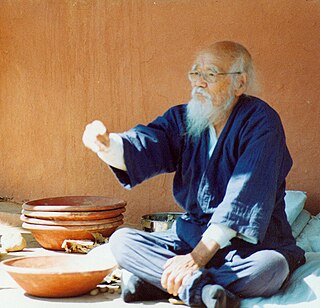
Natural farming is an ecological farming approach established by Masanobu Fukuoka (1913–2008), a Japanese farmer and philosopher, introduced in his 1975 book The One-Straw Revolution. Fukuoka described his way of farming as 自然農法 in Japanese. It is also referred to as "the Fukuoka Method", "the natural way of farming" or "do-nothing farming". The title refers not to lack of effort, but to the avoidance of manufactured inputs and equipment. Natural farming is related to fertility farming, organic farming, sustainable agriculture, agroecology, agroforestry, ecoagriculture and permaculture, but should be distinguished from biodynamic agriculture.
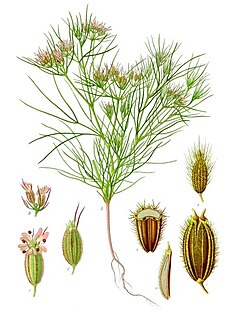
Cumin is a flowering plant in the family Apiaceae, native to a territory including the Middle East and stretching east to India. Its seeds – each one contained within a fruit, which is dried – are used in the cuisines of many cultures in both whole and ground form. Although cumin is thought to have uses in traditional medicine, there is no high-quality evidence that it is safe or effective as a therapeutic agent.
Carbon farming is a name for a variety of agricultural methods aimed at sequestering atmospheric carbon into the soil. Increasing the carbon content of soil can aid plant growth, increase soil organic matter (improving agricultural yield), improve soil water retention capacity, and reduce fertilizer use (and the accompanying emissions of greenhouse gas nitrous oxide (N
2O). As of 2016, variants of carbon farming affected hundreds of millions of hectares globally, of the nearly 5,000,000,000 hectares (1.2×1010 acres) of world farmland. Soils can contain up to five per cent carbon by weight, including decomposing plant and animal matter and biochar.
